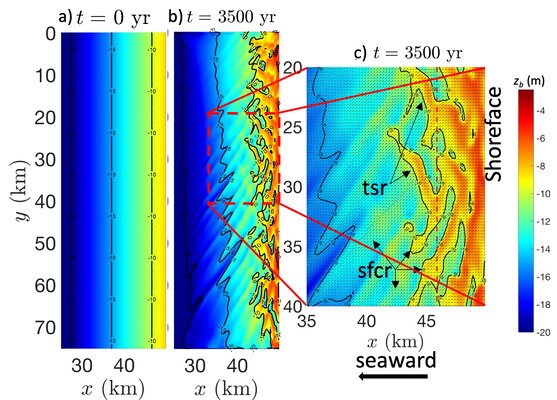A. Nnafie1*, H.E. de Swart1 , T. Verwaest2
1Institute for Marine and Atmospheric Research Utrecht, Utrecht University, The Netherlands; 2Flanders Hydraulics Research, Antwerp, Belgium
* Corresponding author: a.nnafie@uu.nl
Introduction
Sandy continental shelves often feature the presence of large-scale rhythmic bedforms, known as shoreface-connected sand ridges (sfcr) and tidal sand ridges (tsr). These ridges typically evolve on centennial time scales, with spacings of 2-15 km between successive ridge crests, lengths of 10-50 km, widths of 1-10 km, and heights of 5-25 m (Dyer and Huntley, 1999). Typically, sfcr are found on inner shelves frequently exposed to storms, whereas tsr form on outer shelves under strong tidal conditions (tidal range > 3 m). On shelves subject to both frequent storms and strong tides, such as the Belgian shelf, both sfcr and tsr develop.
Studies so far (see the reviews by Ribas et al., 2015; de Swart and Yuan, 2019) have focused either on sfcr, thereby assuming weak tidal conditions (tidal range < 1 m), or on tsr, disregarding wave and wind effects. The objective of this study is to investigate the impact of the combined waves, wind and tide on the long-term evolution of shelf ridges.
Objective and Methods
The coupled Delft3D+SWAN numerical model (Lesser et al., 2004; Holthuijsen, 2007) is applied in a setting representative of the Belgian shelf. An experiment is carried out for a duration of 3500 years, in which the model is forced with waves, wind and tide. This experiment starts from small-scale random bottom perturbations (with root-mean square height of 10 cm) superimposed on the initial bathymetry (panel a in the figure).
Results
Model results (panels b and c in the figure) show that a mix of two type of ridges emerges on the shelf, which resemble the sfcr and tsr observed on the Belgian shelf. However, a notable difference is that observed tsr are located further offshore than modelled ridges. A potential explanation for this difference is the neglectance of sea level rise, which can significantly influence ridge evolution. Effects of sea level rise will be investigated in the coming months, and if succcessful, the results will be presented at the conference.

Snapshots of the simulated bed level zb at times t = 0 yr (a) and t = 3500 yr (b). A zoom-in at t = 3500 yr is displayed in panel c.
References
- Huib E de Swart and Bing Yuan. Dynamics of offshore tidal sand ridges, a review. Environmental Fluid Mechanics, pages 1047–1071, 2019. doi: 10.1007/s10652-018-9630-8.
- Keith R. Dyer and David A. Huntley. The origin, classification and modelling of sand banks and ridges. Continental Shelf Research, 19(10):1285–1330, 1999.
- Leo H Holthuijsen. Waves in oceanic and coastal waters. Cambridge University Press, 2007.
- G R Lesser, J A Roelvink, J A T M Van Kester, and G S Stelling. Development and validation of a three-dimensional morphological model. Coastal Engineering, 51(8):883–915, 2004. doi: 10.1016/j.
coastaleng.2004.07.014. - F. Ribas, A. Falqu´es, H. E. de Swart, N. Dodd, R. Garnier, and D. Calvete. Understanding coastal morphodynamic patterns from depthaveraged sediment concentration. Reviews of Geophysics, 53, 2015. doi: 10.1002/2014RG000457.










